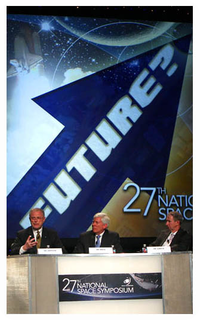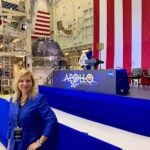Spotlight
Where is NASA Going?
Written by: developer
 Another recurring theme at the National Space Symposium — and, indeed throughout the space industry — is the question of where NASA is heading.
Another recurring theme at the National Space Symposium — and, indeed throughout the space industry — is the question of where NASA is heading.
The NASA’s Direction – Right Plan for the Future? panel, moderated by American Institute of Aeronautics and Astronautics Executive Director Maj. Robert Dickman, USAF (Retired), the panel featured:
- Dr. Michael K .Simpson, president, International Space University
- Dr. Michael D. Griffin, former NASA administrator and eminent scholar and professor, University of Alabama, Huntsville
- Dr. George C. Nield, associate administrator for commercial space transportation, Federal Aviation Administration (FAA)
Simpson started the discussion with an international perspective, saying that confusion about NASA’s direction is not limited to U.S. and that he believes the widespread debate indicates that many people are placing some importance on space.
He also said that global interest in the International Space Station (ISS) is higher than in U.S. “ISS a symbol of the United States as leader, but not as a sole proprietor,” he said.
In some arenas, Simpson said, NASA has been making good exploration progress and is “clearly moving in the right direction by embracing international cooperation on major products and by stimulating existing and new companies.” He added, however, that outside the U.S., people believe that “if the U.S. loses direction, everyone loses direction.”
Simpson completed his opening remarks by saying that civil space will suffer globally for lack of U.S. leadership. “There is lots of discussion globally about what to do in wake of Shuttle retirement,” he said. “We need to have heavy lift for many reasons, politically, technologically and so forth.”
Griffin also approached the question globally, saying that international cooperation is an “element of any sane future in space” and that “it would behoove the U.S. to move forward and invite cooperation with China,” adding that early indications on China’s 2020 space station would involve international cooperation and that an invitation to the U.S. to participate “is possible.”
Targeting specifically on direction, Griffin said “NASA’s ‘direction’ is a bit misleading; NASA doesn’t pick its direction, it’s an executive implementing agency. The ‘NASA direction’ discussion is really about national civil space policy, which is outside of NASA’s purview.”
Commenting on the core question of “what is the rationale for spending public money on exploration?” Griffin said, “Fifty years on, we haven’t settled this yet. But, I believe the purpose is to extend human presence throughout the solar system, which has economic and security benefits.”
Griffin outlined a number of challenges NASA will face as it moves forward:
- Gaining confidence in appropriate government control in how NASA accomplishes goals
- Because commercial providers are essentially a new mode of acquisition, assuring that the new system meets broad procurement goals
- Developing a relative measure of efficiency and avoiding obvious stupidity in programs
Looking at these issues, he said there are three ways it can be managed:
- The “Arsenal Method,” where government has an in-house captive contractor
- Prime contractors, where upfront money and progress payments provide non-market goods that Arsenals can’t
- Arms-length, commercial transactions, following GSA schedules, where he says in the preferred form of acquisition
Griffin said that the new model allows for acquisition of non-market goods without use of federal acquisition regulations (FAR) and that “unless and until we want to overhaul FAR, it is utterly inappropriate to designate preferred providers who are exempt from FAR,” adding that “any mode of purchase that requires government to not act or inherently prevents government entry is inherently flawed.” The example he cited was that DoD employees can travel on both military jets and commercial airline. “They can co-exist,” he said. “in fact, commercial flight can be successful only when it doesn’t require government directives to exist.”
Nield commented that NASA’s mission is to explore, the FAA’s is to regulate, which allows for partnership. He added that initial discussions with other countries regarding regulation for point-to-point travel indicate that there is a prospect for international standardization, even if it might take a while to move forward.
He noted that it’s ironic that we are “marking 50 years of spaceflight accomplishments with the imminent end of U.S human spaceflight capability. But,” he continued. “We already have three rockets – Delta, Atlas and Falcon – so all we need are capsules. Many companies have said they’re ready, which will mark the first time this country has had multiple human spaceflight choices.”
Speaking for the FAA, Nield said that, regardless of NASA and Congressional direction, the FAA wants to promote commercial spaceflight and that, as a regulatory agency, the FAA can enable and support commercial efforts as fair and consistent regulators.
Additional points were made during the Q&A:
Simpson:
- Europe is very invested in robotic exploration, much less on human exploration
- Europe and Japan may be more interested in robotic repair, perhaps internationally, China might be a better partner
- Politicians aren’t really telling us how to build heavy lift, they are telling us where, based on keeping jobs
- Mission success doesn’t give credit for basic research; mission fulfillment is what you are graded on, but basic technology development is not rewarded the same way
- We must show that the ISS is temporary stepping stone to further exploration
Griffin:
- Building heavy-lift using existing technologies is not offensive from policy perspective
- We really don’t fund technology; we fund missions that develop technology
- When funding a mission, it is foolish if it must have advanced technology — that is just other way to say “cost overrun”
Nield:
- There is no appropriate sense of urgency in closing our technology gap
- For inspiration, consider interest in space tourism, space entrepreneurship; these areas can be a boon to NASA’s public outreach
Pictured: Simpson, Nield and Griffin
This article is part of Space Watch: June 2011 (Volume: 10, Issue: 6).


